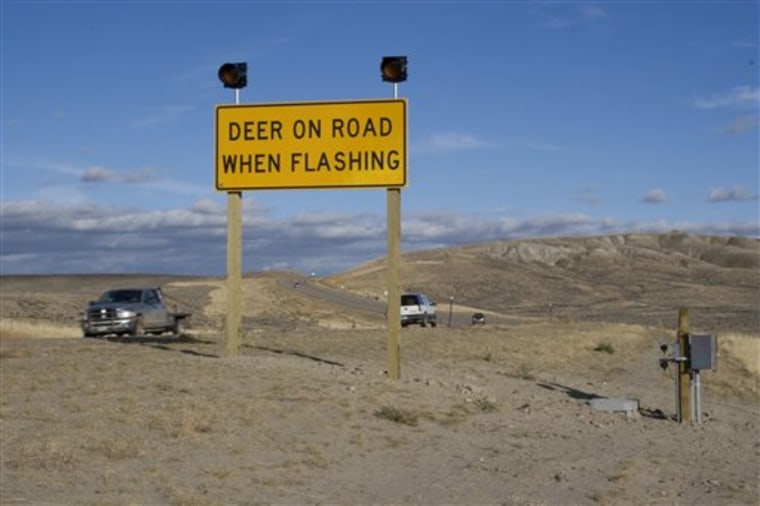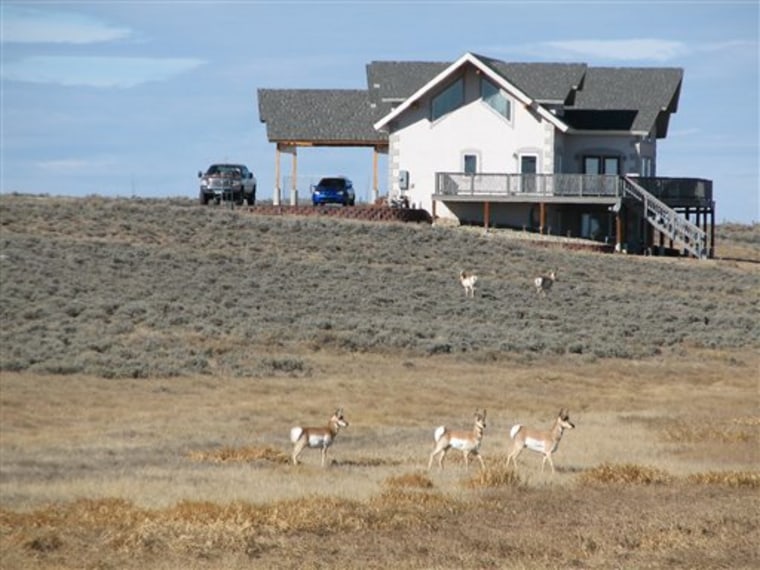The sophisticated motion sensors that line a one-mile stretch of highway in western Wyoming seem out of place. There are no pricey jewels, no rare artifacts, just desolate landscape.
The equipment is here because every fall and spring, 300 to 450 pronghorn antelope cross the bustling two-lane on their journey between the snowcapped mountains in Grand Teton National Park and the expansive, sagebrush-covered mesas and hills of southwestern Wyoming.
The journey extends about 160 miles; of all the mammals in the Western Hemisphere, only the Arctic caribou migrates farther. And every year the pronghorn’s trek gets a little tougher: more homes, more fences, busier highways.
If growth continues unchecked, some biologists fear the migration routes may be cut off.
The nearly $900,000 detection system is one of the measures wildlife managers have taken to help thousands of pronghorn and deer make the increasingly dangerous trek between summer and winter stomping grounds in western Wyoming. And local authorities say they’re mindful of the animals when deciding whether to allow development projects.
Supporters of the herds propose a more unified approach to protect the pronghorn, which have used this route for some 6,000 years — the first federally protected wildlife migration corridor.
“It’s truly unique, and quite frankly, special in a nation of 350 million people that we have migration at this distance,” said Joel Berger, a senior scientist with the New York-based Wildlife Conservation Society who studies the herd.
Along their migration route, the pronghorn come across three “bottlenecks,” or areas where their path narrows because of the terrain. The narrowest is about the length of a soccer field. The speedy pronghorn prefer wide open spaces.
'Like a gantlet'
“They just run through it when they get there, probably because it’s so narrow,” Berger said. “It’s kind of like a gantlet.”
All the bottlenecks have private homes that squeeze the path but are not dense enough to sever the migration route, according to Berger.
A booming energy industry has brought more people to the area, including Sublette County, which encompasses about half the pronghorn migration route and a number of deer migration paths.
The county, bigger than Rhode Island but with only about 7,300 residents, issued a record number of building permits last year and created about 1,000 new residential lots in the last few years.
While homeowners are generally good about not disturbing the migration, more homes bring more fences that pronghorn find difficult to navigate, more dogs that harass the wildlife and more all-terrain vehicles that scare the animals.
“There’s a lot of direct impacts from a subdivision, but there’s a lot of indirect impacts, too,” said Bernie Holz, regional wildlife supervisor for the state Game and Fish Department.
And there’s more vehicle traffic, particularly at the bottleneck known as Trapper’s Point, where fur traders, mountain men and others rendezvoused in the early 1800s. Now it’s a National Historic Landmark with a small monument overlooking the migration route.
Trapper’s Point is the only bottleneck where a highway cuts through the path. With help from federal grants, Wyoming in late 2005 erected the motion sensors, which trigger flashing lights on signs where when wildlife cross.
Dozens killed over five years
The state transportation department says 49 deer and three pronghorn were killed in the area between 2002 and 2006. More deer are hit because they tend to travel when it’s dark, while pronghorn prefer the daytime.
Bob Maxam, a state highway engineer in Pinedale, estimated the system has reduced automobile-wildlife crashes by 60 percent.

Officials are taking other measures to keep the migration routes open.
Bart Myers, planning director of Sublette County, said the county considers wildlife when reviewing proposed subdivisions and imposes certain restrictions, such as requiring wildlife-friendly fencing. Last year, the county denied one proposed subdivision within the antelope migration route.
Disturbances such as oil and gas operations are barred from the corridor, but the Wildlife Conservation Society and others say the federal government should protect it further. Their proposal to establish the nation’s first protected wildlife corridor would impose other restrictions, such as requiring wildlife-friendly fencing.
Any move to establish the special corridor would need support from the state’s congressional delegation because it would require federal approval, said Berger, who is also a professor at the University of Montana. That could prove a tough sell in Wyoming, where interference and restrictions on private land use are loathed by many.
Rep. Barbara Cubin, the state’s lone representative in the House, suggested she would be opposed to the idea.
“The people of Wyoming know far better than the federal government how best to manage their lands, and I will continue to make sure they have the rights to do so,” the Republican said.
